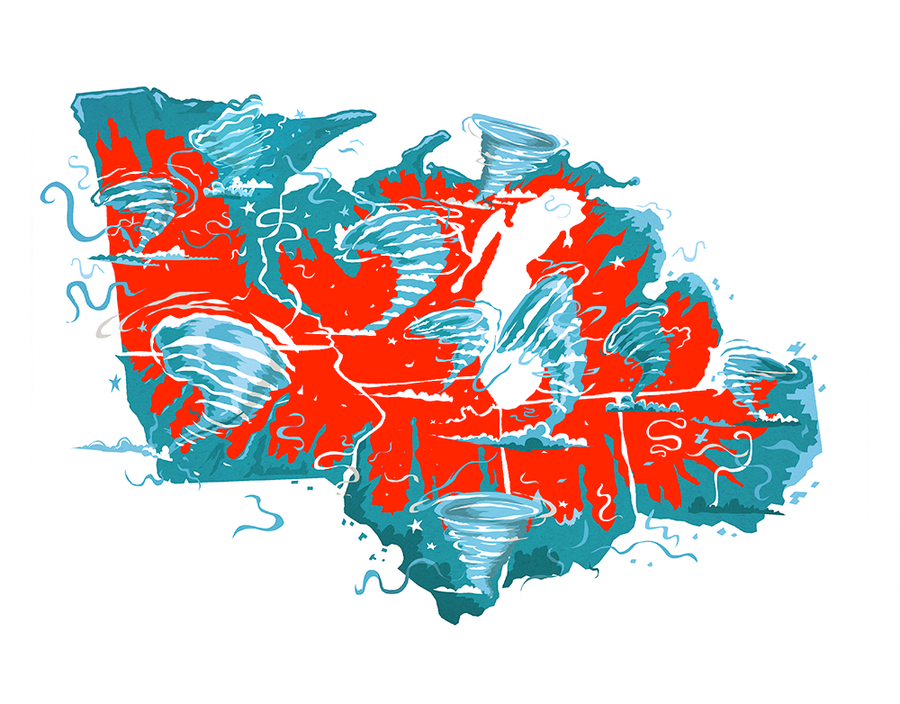The High Stakes of Mapping the Midwest
How can a state continue to be deadlocked with a legislature controlled by Trumpian Republicans when it’s been busy electing not just Democrats but, in many cases, progressive Democrats?
John Nichols

The Republican Party was founded in the upper Midwest, with the strongest claim to the founding location staked by the east-central Wisconsin community of Ripon, population 7,823. There, on March 20, 1854, some 16 anti-slavery activists— several from a nearby socialist community inspired by French radical Charles Fourier — gathered in a little white schoolhouse to organize disparate anti-slavery groups into a new political party.
“We went into the little meeting held in a schoolhouse [as] Whigs, Free-Soilers and Democrats,” recalled Alvan Bovay, the main organizer of the meeting. “We came out of it Republicans.”
The party took hold in the small towns and rural stretches of a region where opposition to slavery combined with the vision of a politics that respected immigrants and supported the struggles of the laboring classes of a still young nation. Six years after its founding, the party’s Abraham Lincoln became president of the United States.
The Republicans would go on to win the vast majority of presidential elections over the next 164 years.
But today’s Republican Party is no longer the Grand Old Party of Lincoln and Ulysses S. Grant and Teddy Roosevelt and Dwight Eisenhower. The universal appeals to Abe’s “better angels of our nature,” Teddy’s “square deal for all” and Ike’s “peace and prosperity” have been replaced by Donald Trump’s dark mutterings about serving as a dictator for a day and MAGA battle cries against immigrants and socialists — like the ones who formed the GOP in Ripon.
Those stark statements of MAGA fury are far less appealing than the one-nation, big-tent politics of the party of Lincoln that, in the late 19th century, seemed an unstoppable political force. Republicans are no longer confident they can win elections based on the popular appeal of their positions or their candidates. The polls tell the story, says Ben Wikler, chair of the Democratic Party of Wisconsin: “Most Wisconsinites, most Americans, don’t approve of Donald Trump or where the Republican Party is headed.”
Since 2018, Wisconsin Democrats have been on a remarkable winning streak: flipping control of the governorship from right-wing, anti-labor zealot Scott Walker to Democrat Tony Evers, then reelecting Evers by a comfortable margin in 2022. Electing and reelecting Attorney General Josh Kaul. Securing most other statewide posts. Establishing a progressive majority on the state Supreme Court. Swinging a state that narrowly backed Trump in 2016 to Biden in 2020.
But Evers has struggled to govern because, despite the Democratic winning streak, Wisconsin’s state legislature remains under tight Republican control. In fact, Republicans hold close to two-thirds of the seats in the Wisconsin State Assembly and Senate.
How can a state continue to be deadlocked with a legislature controlled by Trumpian Republicans when it’s been busy electing not just Democrats but, in many cases, progressive Democrats?
“Over a decade of gerrymandering,” explains state Sen. Melissa Agard. But things might be changing for the better.
For years, as an activist and Democratic Party leader, Agard recruited able candidates, raised money and personally campaigned across Wisconsin. Regardless, Republicans kept winning because the lines of their districts were drawn with such bias that even the best Democrats were destined to be defeated by Republicans dramatically out of touch with the state’s overall electorate.
To be fair, Democrats engage in gerrymandering too. But what’s happened in Wisconsin — and a number of Midwestern states — is an often missed and misunderstood part of why the GOP of 2024 has abandoned so much of its history. Not just legislative district maps are gerrymandered; so, too, are the lines that define congressional districts, making it a national concern.
No doubt, big money from billionaire donors and corporate interests is a factor. So, too, are the crudely racist and xenophobic manipulations of public opinion that Republicans like Trump and his state-based acolytes have made central to their appeals to disenfranchised and disenchanted working-class voters.
But if you want to know why the Republican Party has become such a haven for extremism and bad craziness, you can’t neglect the fact that many of its most noxious officials get elected and reelected from Midwestern legislative and congressional districts where they literally cannot lose.
Where Republicans once tried to appeal to the whole of the electorate, they now primarily appeal to voters in heavily gerrymandered districts that reward extremism. That influences the options available in fall elections and, more importantly, the direction of government.
In Wisconsin, when Walker was governor, gerrymandering made it possible for Republicans to implement an exceptionally unpopular right-wing agenda that was favored by out-of-state billionaires and corporate political action committees — including moves to undermine the ability of workers to organize unions and collectively bargain, cut education funding and gut state and local services. Yet, even when Walker’s agenda inspired mass protests that attracted national and international media attention, Republicans kept control of a gerrymandered state legislature.
At the heart of the manipulation was the radical redrawing of legislative district lines such that, even when most Wisconsinites cast Democratic ballots, legislative chambers would remain under complete Republican control. The Princeton Gerrymandering Project described the Wisconsin district lines as “some of the most extreme partisan gerrymanders in the United States.”
How extreme? In 2012, while 48.6% of voters backed Republican candidates for the Wisconsin Assembly, Republicans “won” 60 of 99 seats. There was “no question — none — that the recent redistricting effort distorted the vote,” explained University of Wisconsin-Madison political science professor Kenneth Mayer.
Even following the 2018 election, when Evers beat Walker and Democrats won every statewide race — including that of progressive U.S. Sen. Tammy Baldwin — the makeup of the legislature did not materially change. “Republicans enjoy a built-in 64-35 advantage in the partisan makeup of the 99 Assembly districts,” explained a Milwaukee Journal Sentinel analysis in December 2018. “In a hypothetical 50-50 election, in which there are equal numbers of Democratic and Republican voters in Wisconsin, no one crosses party lines and independents split down the middle, that translates into a massive 29-seat GOP advantage in the Assembly. That’s very close to the 27-seat margin (63−36) that Republicans won last month.”
After the 2000 Census, when there were hopes for reform — as occurred in neighboring Michigan, where a decade-old gerrymander of that state’s legislative maps was upended by a citizen-initiated referendum that established an independent redistricting commission — little changed in Wisconsin.
Then, in April 2023, voters elected progressive Judge Janet Protasiewicz to the state Supreme Court, establishing a 4-3 progressive majority. Protasiewicz campaigned on an argument that gerrymandering was anti-democratic, as had other progressive justices, and the court took up election reform cases to quickly establish a timeline for the drawing of competitive maps. Republican legislative leaders saw the writing on the wall and began working with Evers to approve fair maps.
Suddenly, there are competitive primaries and expected general-election matchups in Assembly and Senate districts across Wisconsin. “Now, Wisconsinites have a fair shot at real representation,” says Assembly Minority Leader Greta Neubauer, a Racine Democrat who has recruited Democratic candidates in urban, suburban and rural districts.
Neubauer hopes for the election of a lot more Democrats, and she is likely to get her wish. But where Democrats don’t win, the Republicans who prevail could well be more reasonable.
That’s because, to prevail in more competitive districts, Republicans will have to worry less about being the most extreme candidate in a GOP primary and more about being an acceptable candidate in November.
That, explains Bill Whitford, a retired law professor from Madison who has fought for fair maps for decades, could lead to a more thoughtful and responsible politics in a state where legislative Republicans have recently refused calls by Evers for special legislative sessions on gun violence, police brutality, the pandemic and workforce development.
Even if Republicans retain control of one or more chambers of the Wisconsin legislature, Whitford says, the executive and legislative branches of state government might break deadlocks on issues that shouldn’t be controversial, like expanding access to childcare. That’s a baseline hope. Ideally, says Whitford, with Democrats in charge of the governorship, the Assembly and the Senate, Wisconsin could see dramatic progress — as Michigan has — on progressive priorities such as expanding reproductive rights, restoring protections for unions and providing adequate funding for higher education.
There are similar hopes in Ohio, where gerrymandering has not just given Republicans control of the legislature but created a dynamic such that the state’s conservative Republican governor, former U.S. Sen. Mike DeWine, has clashed with even more right-wing Republicans while Democrats are often shoved to the sidelines. This year, more than 700,000 Ohioans signed petitions circulated by the Citizens Not Politicians movement, which proposes to amend the state constitution so a 15-member commission — made up of Ohioans from across the state — can draw legislative and congressional district maps. A reform initiative is now on the November ballot, and Ohio League of Women Voters Director Jen Miller says Ohioans are excited to have a chance to “finally end gerrymandering.”
An end to gerrymandering opens up the possibility, even in the era of Trump, that some newly elected Republicans might be interested in governing with an eye toward resolving problems rather than creating them. That reasonableness was once associated with Midwestern Republicans like Ohio Congressman William Moore McCulloch, who played a critical role in civil rights legislation, and Wisconsin Gov. Lee Sherman Dreyfus, who approved the nation’s first statewide ban on discrimination against LGBTQ+ individuals and families.
We’re still a long way from the Republican Party renewing their commitment to the progressive ideals associated with the founding of their party in that little white schoolhouse in Ripon. But ending gerrymandering in the Midwest holds out the prospect for a better Republican Party, for a better politics in general, and ultimately, for the progressive policy gains that have been too long denied in too many Midwestern states.








